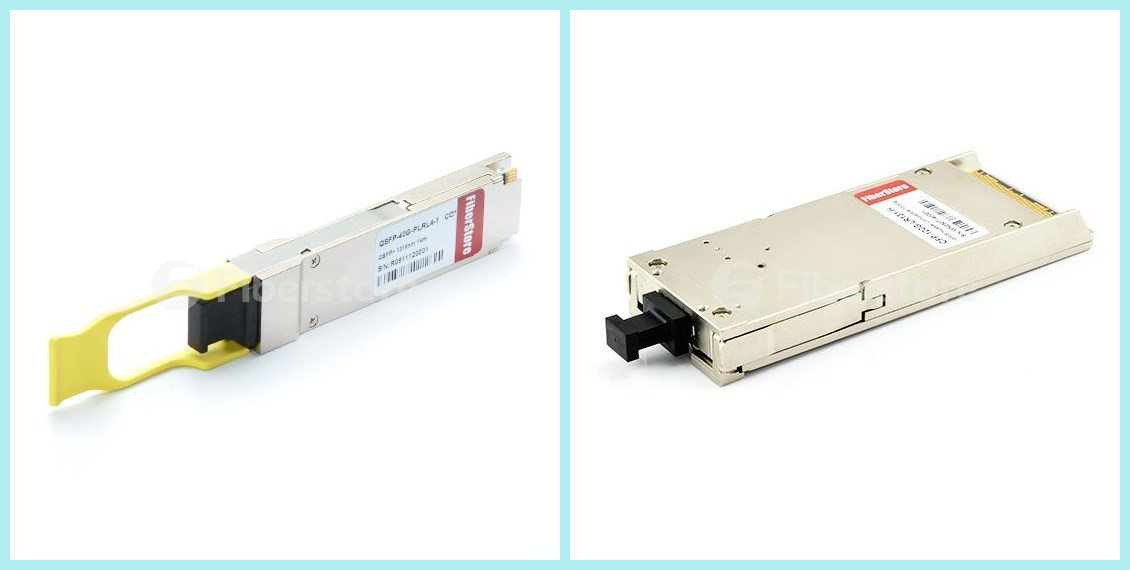Today many factors drives the need for high data rates, such as virtualization, convergence and high-performance computing environments, etc. So more and more servers, routers and network switches will be added to 40G/100G data centers to handle the increased data traffic. Thus, the optical fiber installation needs migration. But what kind of cable is the most suitable for 40G/100G data centers? To answer this question, we have to learn some thing about one of the connectivity equipment–40G/100G transceivers.
Fiber Optical Transceivers
Different data rates need different transceiver modules. There are SFP (small form-factor pluggable), SFP+ modules for 1G and 10G network, and QSFP+ (quad small form-factor pluggable), CFP (centum form-factor pluggable ) for 40G and 100G network. All of theses transceivers have various types according to form factor. For example, 40GBASE-SR4 and 100GBASE-SR4 (as shown in the following picture) are most often used for 40G and 100G. It uses 4 parallel fibers for transmission and 4 lanes.

MPO/MTP Connectors
MPO/MTP connectors are the most prevalent connector type used in the system. Standard 12-fiber MPO are configured. 4 fibers are used for transmission and 4 fibers are used for receive function. The other 4 fibers in the middle are left unused of “dark” fibers.
However, this method may cost more because the fibers are not fully used. If upgrade the system to 100G with a similar 4x25Gbs scheme, the same fiber arrangement can be used. By using conversion harness or interconnect modules, all 12 fibers of a ribbon can be utilized until the interconnection with optical modules is required. The use of ribbons allows for easier connection (less opportunity to cross fibers in an MPO connector), and perhaps more importantly, achieves easier polarization continuity regardless of the polarity method selected for the system.
Comparison Between Ribbon Cable with Armored Versions
Before installing cables, several factors should be considered to decide the cable design. The following will compare ribbon cable with armored versions from the sides of fiber count, cable size, ruggedness of design, and cost.

The fiber density is a very attractive feature of these cables especially as fiber counts increase in the data center. A 48-fiber cable ribbon design the outside diameter is about 40% of armor design cable of the same fiber count.
Besides, the cable diameter is also important because the cable is often installed in a conduit system. If the installed cable diameters in the conduit are very high, then the cable installation will be problematic. Maybe the installed cables will be damaged. In comparison, to install 3 armored cables and 3 ribbon cables in a conduit respectively, the amount of “headroom” for the installation using a ribbon cable design is evident.
Of course, except the cable size, there are other factors to determine the cable construction. For example, every cable installation is not the same length or has the same number of bends at the same angles. Installation methodologies are different and depending on the length of cable, its weight, tensile strength must also be taken into consideration. Ribbon cables are flexible and strong and less likely to cause problems during the cable pull process.
At last, the cost is often considered for every installation. The ribbon cable is very cost effective with high fiber counts. For ribbon cables, the fiber counts can be 8, 12, 24, 36, 48 and 72 and easily terminated with MPO/MTP connectors.
Conclusion
Ribbon cables have been used in the network for more than 20 years. The above content obviously shows their advantages of fiber density, size and cost. They are specially suitable for 40G/100G data center builds. In the long run, the ribbon cables are good for future data rate expansion.
Originally published at www.fiber-optic-equipment.com/
No comments:
Post a Comment